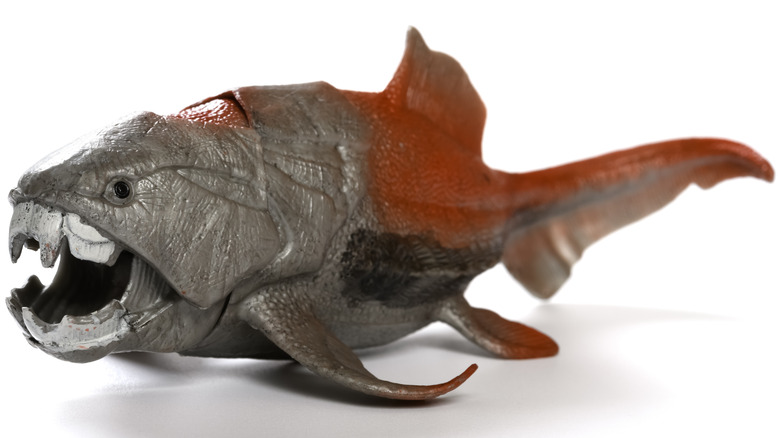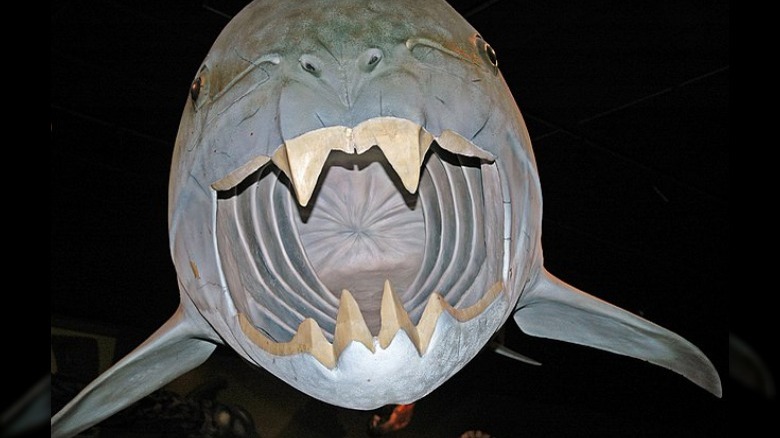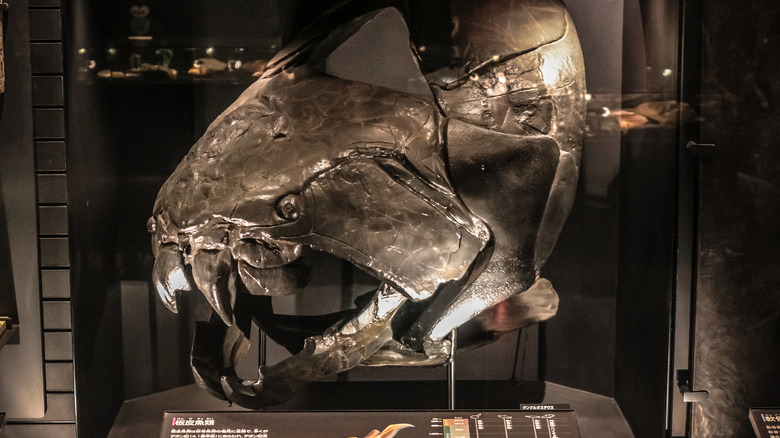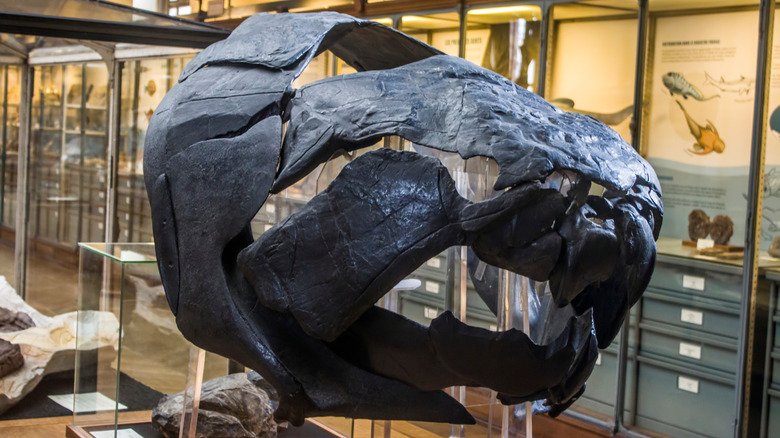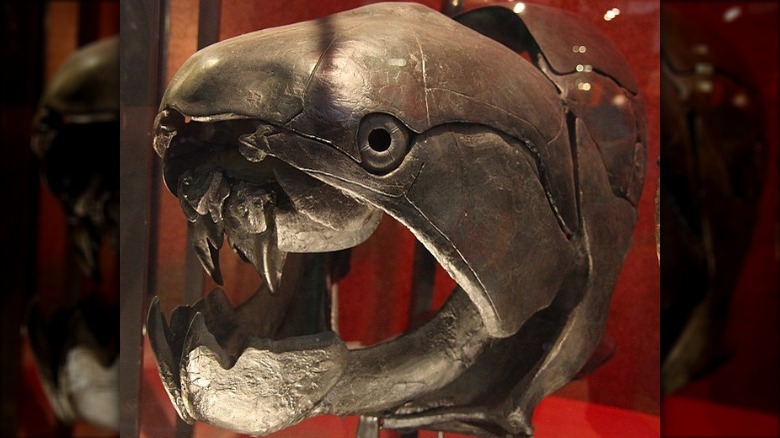The Biggest Theories Why This Scary Fish Went Extinct
An armor-skinned apex predator weighing up to four tons and reaching lengths of around 30 feet, swimming in waters covering parts of what is now parts of the American Midwest (via ThoughtCo and MLive)? That's just what the Dunkleosteus was, according to Reuters, and in its day, some 400 million years ago in the Devonian period, this fish was a fearsome sight. That would be true for a human, if any happened to live that long ago, or for the wide range of ocean life Dunkleosteus ate, including other armored fish, early sharks, and tentacled ammonoids — a now extinct cousin of the modern nautilus (per Britannica).
When your enormous mouth, also covered in armor plates, is able to snap shut in a matter of milliseconds like the Dunkleosteus' jaw could, applying thousands of pounds of pressure in a single bite, it's always feeding time. The Dunkleosteus lived before the dinosaurs — the first of which appeared during the Triassic, roughly 250 million years ago, per the U.K.'s Natural History Museum — and had no known predators. With advantages like these, how, then, did this formidable member of the now-extinct placoderm class of fish — meaning, "armored fish" (per Nature) — go extinct?
The Dunkleosteus was discovered in 1867
According to FossilGuy, the Dunkleosteus was discovered by amateur paleontologist Jay Terrell and his son in the 1860s on the shores of Lake Erie in the North American Great Lakes region. At that time, the father-son duo called what they found the "terrible fish." Paleontologist David Dunkle — one-time curator of the Cleveland Museum of Natural History, according to the Ohio Memory Collection — also excavated and studied "terrible fish" fossils found in the upper Midwest area. In the mid-20th century, the ancient creature was called Dunkleosteus terrelli, shortened to Dunkleosteus, and named after both researchers.
Since then, as ThoughtCo. goes on to note, a large number of Dunkleosteus fossils have been found. Science also now has a pretty good idea of what life was like in the tropical seas that covered parts of North America at the time, which were shallower than modern seas but still full of life. In addition to the prey already mentioned — other fish and sea life swimming alongside this vicious giant — Dunkleosteus terrelli also ate one another when they ran low on food, according to science. Based on Reuters reporting, the Dunkleosteus' mouth opened and shut so quickly that suction was formed. Once prey was caught in the vacuum, its fate was sealed.
A jaw as powerful as a T. Rex's
Per Reuters, few living creatures known to science — living or extinct — could apply as much force with their jaw as the Dunkleosteus, besides some alligators, crocodiles, and the popular dinosaur predator, T. Rex. That said, the Dunkleosteus had no teeth but chomped its food instead with two blade-like bone structures. Pressure applied by the Dunkleosteus' mouth at the very tip is estimated to have reached 80,000 pounds per square inch and around 11,000 pounds per square inch deeper in its mouth. In terms of jaw power alone, the Dunkleosteus terrelli leaves today's great white shark in its wake.
Those pressure-per-square-inch estimates were reached through a Field Museum in Chicago and University of Chicago study using a biomechanical model of the Dunkleosteus' jaw based on the fossil record. Speaking with Reuters, the study's lead author Philip Anderson said, "Dunkleosteus was able to devour anything in its environment." Notably, much less is known about the back half of the terrible fish than the front, based on the fossil record, according to Prehistoric-Wildlife. Many recreations of the Dunkleosteus' body, in fact, are based on a much smaller placoderm called Coccosteus, of which there's plentiful fossil evidence. The Coccosteus measured only around 40 centimeters, or around 16 inches (via Rapid Tables).
There were 10 species of Dunkleosteus
What's also notable about the Dunkleosteus is that there were in fact 10 different species that lived all over the world. The most well-known, Dunkleosteus terrelli, was found not only in the North American Great Lakes region but also in parts of Texas and California. Other species of Dunkleosteus have shown up in Northern Africa and Western Europe, as ThoughtCo. explains. Another enormous fish that a time-traveling scuba-diving human might encounter during this period was the Titanichthys or titan fish, that matched the size of the Dunkleosteus but, but according to evidence, was not an apex predator. The Titanichthys was perhaps an early filter-feeder, according to Prehistoric-Wildlife.
Clearly, these giant fish had a good reign in the waters of the Devonian period, which is sometimes called the age of fishes, according to Britannica. So what went wrong? Per Reuters, we may never know for certain exactly how and why placoderms vanished from Earth. The conclusion of the Devonian period, when these creatures flourished, coincided with what some scientists call one of Earth's six great, or mass extinctions, as the American Museum of Natural History (AMNH) explains. As a result, by the end of the Devonian period, or roughly 370 million years ago, large swathes of undersea life were wiped out in a timespan that, according to some estimates, lasted from 500,000 years to as long as 25 million years. Either way, by the end of that extinction period, placoderms were gone.
The Kellwasser Event
What exactly happened in the late Devonian period that spelled the end for so many of Earth's underwater species? Again, science may never know the precise cause of this mass extinction, but as the American Museum of Natural History (AMNH) explains, there were likely two factors, combined with a sudden abundance of plant life on land, which drastically changed Earth's atmosphere. Those changes came with the Carboniferous period, a warmer and more humid time when many of Earth's coal deposits are thought to have formed. It's also when glaciers began to build up on the planet's poles in alternating periods of glacial and interglacial activity, according to the Smithsonian Environmental Research Center.
Along with that, evidence suggests something called the Kellwasser Event happened in the Devonian period (per AMNH), possibly caused by comet impact, according to a 2005 report from the Annual Meteorological Society. Regardless of how it happened, the Kellwasser Event was accompanied by a sharp drop in water oxygen levels, sometimes to the point of anoxia or a complete lack of oxygen, based on Discover Magazine reporting. Many underwater species were literally suffocated in waters where they were once bountiful, but especially invertebrates like corals and sponges. The sharp drop in water-oxygen levels known to have happened in the Kellwasser Event also likely killed or stressed placoderm species who failed to transition to the new period.
The Hangenberg event
Similar to the Kellwasser Event, the so-called Hangenberg Event saw a sharp drop and sometimes complete lack of oxygen in Earth's waters, possibly caused by volcanic activity (via Nature). With that, many species destined to fall during the late Devonian mass extinction were no more, including species of Dunkleosteus and their placoderm relatives. With Dunkleosteus prey threatened (or in some cases, gone) and large parts of Earth's water completely devoid of oxygen and no longer inhabitable, the sheer size of some Dunkleosteus species may have also turned into a disadvantage, as ThoughtCo. points out.
Supporting this claim, the end of the Dunkleosteus led to the flourishing of shark species. Some were smaller but almost all were more agile — like a fighter jet versus a B-52 bomber — and able to better adapt to the new water conditions and prey variety. The Carboniferous period, in fact, is called the "golden age of sharks," according to the U.K.'s Natural History Museum (NHM). The ascendency of the shark led to the evolution of the megalodon, which reach lengths of 18 meters or around 60 feet (via Meters-to-Feet). The megalodon — which went extinct around 3.6 million years ago (via NHM) — is also among the only creatures known to science that matched the Dunkleosteus as far as bite power, per ThoughtCo.
